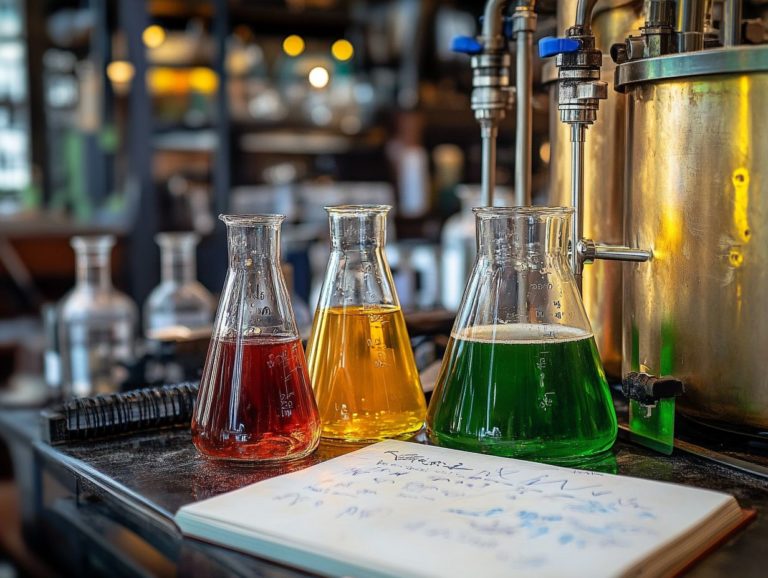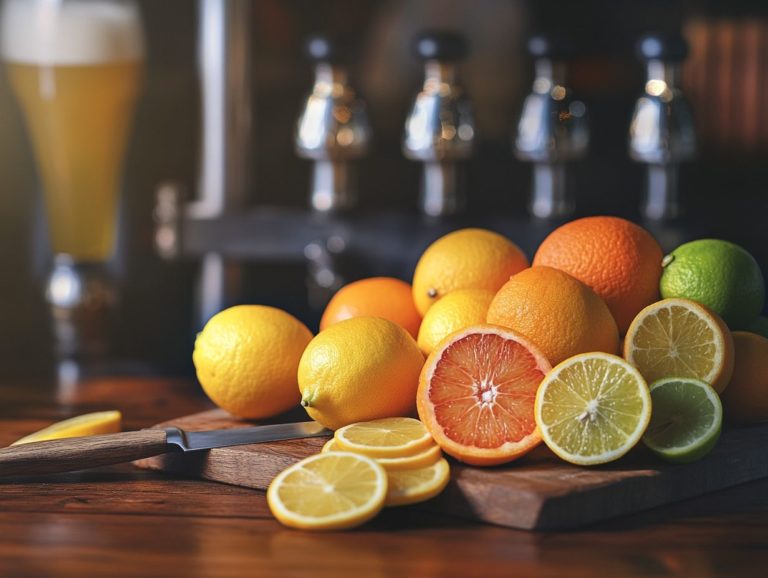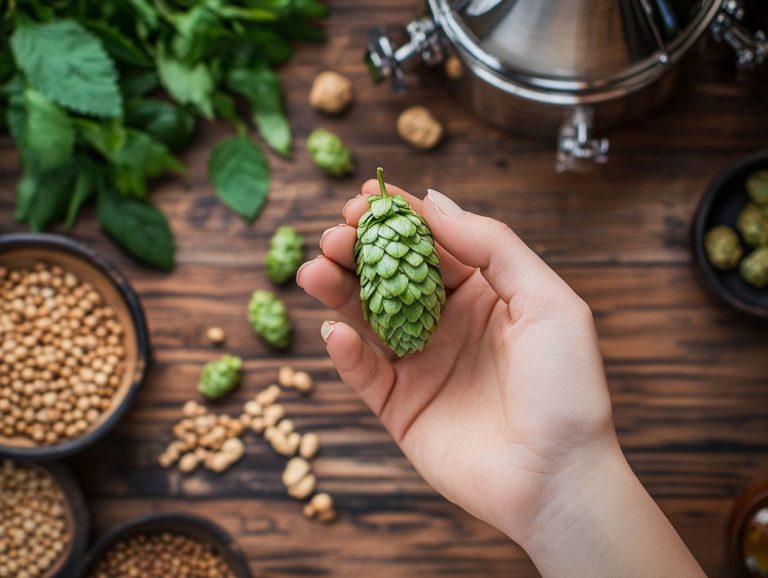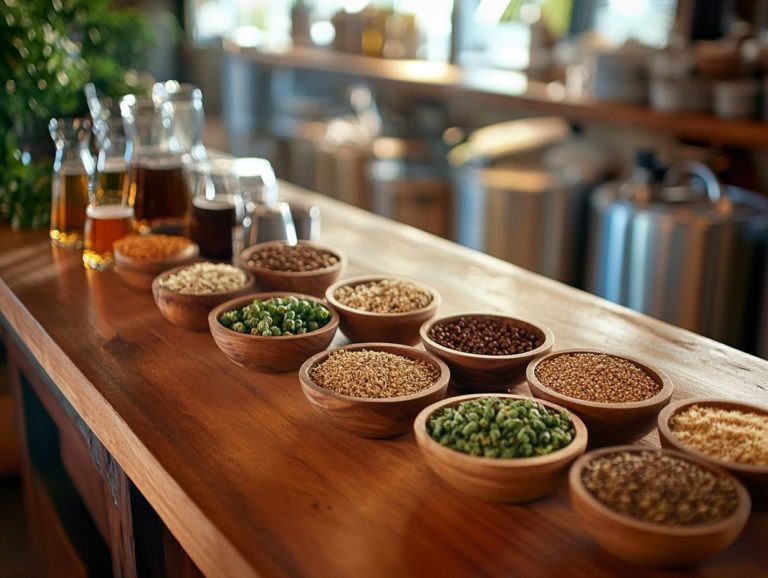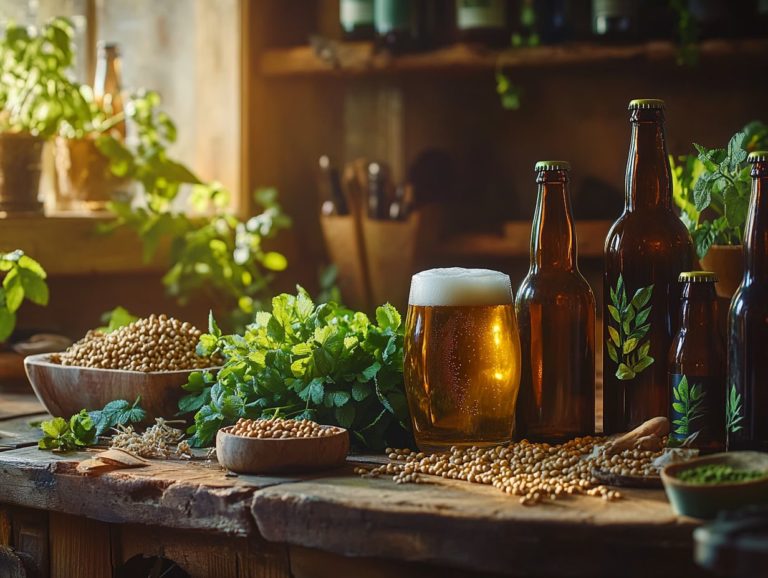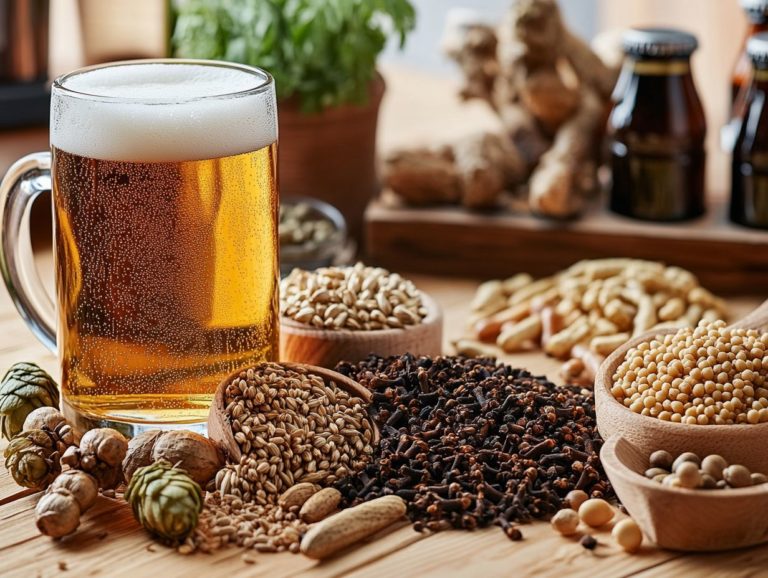Exploring Different Types of Yeast for Brewing
Yeast is the unsung hero of brewing, serving a pivotal role in transforming simple ingredients like barley and hops into exceptional beverages that tantalize the palate.
This exploration delves into the various types of yeast utilized in brewing, ranging from the well-known ale and lager yeasts to the fascinating world of wild yeasts and souring bacteria. Each type contributes its own unique characteristics, influencing fermentation temperature, flavor profiles, attenuation, flocculation, and the overall outcome of your brewing endeavors.
Discover how these diverse yeast strains can elevate your brewing game and empower you to craft the perfect beer that stands out in any collection.
Contents
- Key Takeaways:
- What Are the Different Types of Yeast Used in Brewing?
- What Are the Characteristics of Each Type of Yeast?
- 1. Fermentation Temperature
- How Do Different Types of Yeast Affect the Brewing Process?
- 1. Fermentation Time
- 2. Flavor Development
- 3. Alcohol Content
- What Are the Best Uses for Each Type of Yeast?
- 1. Ales for Complex Flavors
- 2. Lagers for Crisp and Clean Beers
- 3. Wild Yeast and Brettanomyces for Funky and Unique Beers
- 4. Souring Bacteria and Brettanomyces for Tart and Sour Beers
- 5. Specialty Yeast for Experimental Beers
- Frequently Asked Questions
- What is the role of yeast in the brewing process?
- What are some specialty yeast strains used in brewing?
- How do I choose the right yeast for my homebrew?
- Are there any alternative types of yeast that can be used for brewing?
Key Takeaways:
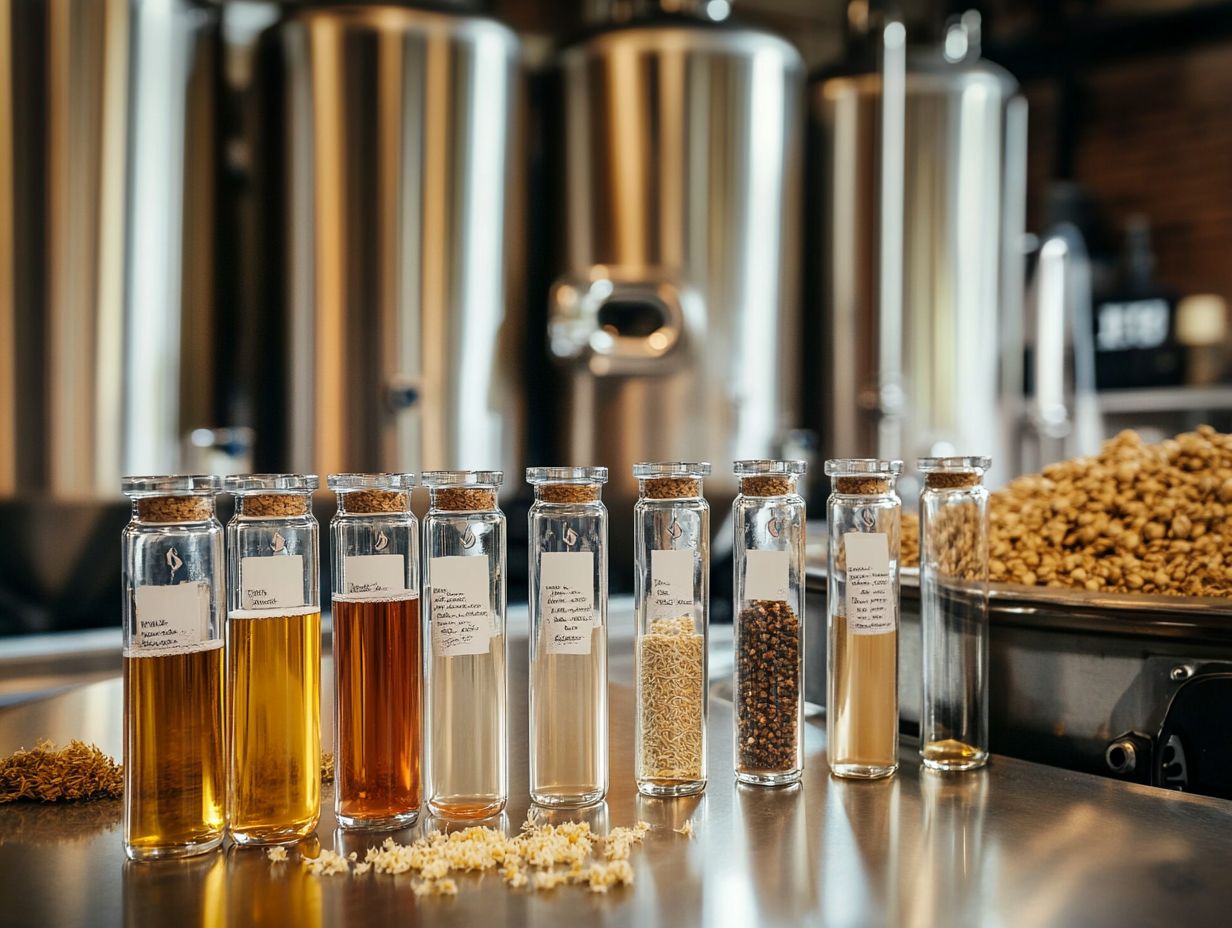
- Ales and lagers are the most commonly used yeasts in brewing, but there are also wild yeasts, souring bacteria, and specialty yeasts that can be used for unique and experimental flavors.
- The characteristics of each type of yeast, such as fermentation temperature, flavor profile, attenuation, flocculation, and alcohol tolerance, greatly impact the final product of a beer.
- Different types of yeast can affect the brewing process in terms of fermentation time, flavor development, and alcohol content, making it important for brewers to choose the right yeast for their desired outcome.
What Are the Different Types of Yeast Used in Brewing?
The world of brewing is a tapestry woven with a variety of yeast types, each one adding its own unique flair to the beer-making process. Yeast is not just an organism; it’s the unsung hero of fermentation, working diligently to transform wort into the delightful beverages you savor today. This journey of yeast, from ancient brewing history to modern craft beer, showcases its paramount importance in creating unique beer styles.
Among the most well-known types are Ale and Lager yeasts, each distinguished by their fermentation profiles and flavor contributions. But it doesn t stop there wild yeast strains and souring bacteria can bring an intriguing array of complex, tangy notes to your beers.
Specialty yeasts, like Kveik and Brettanomyces, open up a realm of creative possibilities for the adventurous brewer. Throughout history, brewers have embraced these diverse yeast types to craft a stunning array of beer styles, from IPAs to stouts and Belgian ales, each one a testament to the artistry of brewing.
1. Ale Yeast
Ale yeast, primarily Saccharomyces cerevisiae, is your go-to for fermentation at warmer temperatures, usually ranging from 60 F to 75 F. This temperature range is where the magic happens, as it fosters the development of fruity esters, phenolic compounds, and a rich flavor profile.
This remarkable ability to thrive in various brewing environments is what allows it to play a pivotal role in shaping different ale styles. Take American ales, for example; they often burst with citrusy and piney hop characteristics, harmoniously balanced with a hint of malt sweetness, all thanks to the specific yeast strains at play.
In contrast, British ales tend to embody a delightful balance of caramel and toffee notes, enhanced by the yeast s knack for producing lighter fruity esters. Belgian ales, on the other hand, are truly in a league of their own. They boast a complexity that comes from the yeast s ability to generate spicy phenols and a delightful medley of indistinct fruity flavors, culminating in a beautifully aromatic experience.
It s this exceptional versatility that positions ale yeast as an essential ingredient in the brewing craft, offering a wide spectrum of flavors to satisfy every palate, from the malty notes of a British ale to the diacetyl-free profile of a well-crafted American ale.
2. Lager Yeast
Lager yeast, predominantly Saccharomyces pastorianus, ferments at cooler temperatures, typically between 45 F and 55 F. This cooler environment results in the clean taste and smooth finish that define many popular lager styles, such as Pilsner, M rzen, and Altbier.
This unique fermentation process allows the yeast to produce fewer esters and phenols compared to ale yeasts, which thrive at warmer temperatures and tend to deliver more fruity and spicy notes. Consequently, the flavor profiles of lagers are generally more subdued, emphasizing malt and hop characteristics, which make them incredibly refreshing.
Varieties like Helles, with its slightly sweet malt backbone, and Bock, known for its richer, fuller flavor, exemplify the versatility of lager yeast. Domestic yeasts also fall within this category, often bringing a house character to the brews. By understanding these intricacies, you can deepen your appreciation for the craftsmanship behind each style, enhancing your overall enjoyment of this quintessential beer category.
3. Wild Yeast
Wild yeast, particularly Brettanomyces, presents a captivating alternative in the world of brewing, infusing complex and often funky flavors that can significantly enhance the character of certain beer styles, especially sour ales, farmhouse ales, and barleywine.
This remarkable microorganism, known for its ability to thrive in unpredictable environments, plays a crucial role in the fermentation process, imparting distinctive notes of earthiness, fruitiness, and even a hint of spice.
As you delve into the realm of brewing, consider embracing the unpredictable nature of wild yeast; it invites experimentation with traditional styles like Lambics and Goses, resulting in beers that showcase a terroir reminiscent of fine wines. By allowing wild yeast to coexist with more conventional strains, you create an intriguing interplay of flavors that caters to adventurous palates in search of novel tasting experiences.
The journey of discovery that wild yeast presents can lead you to truly exceptional brews, distinguishing them within the vibrant landscape of craft beer.
4. Souring Bacteria
Souring bacteria like Lactobacillus and Pediococcus are essential for crafting those delightful tart and tangy flavors found in sour ales, adding layers of complexity and depth to the beer s profile through the magic of lactic acid fermentation.
These microorganisms are fundamental to the fermentation process, transforming sugars into lactic acid, which not only contributes to the beer’s sourness but also elevates its aroma and mouthfeel. The interaction between souring bacteria and traditional yeast strains creates a captivating balance, allowing the beer to develop a vibrant character that is both refreshing and intricately layered. Souring bacteria also play a crucial role in reducing unwanted compounds like acetaldehyde and diacetyl during the fermentation process.
Popular sour beer styles, such as Berliner Weisse and Gose, depend heavily on these bacteria to achieve their signature taste profiles, making them a cherished choice among craft beer enthusiasts eager to explore a spectrum of flavor dimensions.
By embracing the natural potential of these bacteria, you can savor exceptional brews that truly stand out in the diverse world of beer offerings, showcasing the intricate yeast profiles that define a well-crafted sour ale.
5. Specialty Yeast
Specialty yeast varieties, such as Kveik, have gained popularity among home and craft brewers. Their robust fermentation characteristics and unique flavors enhance experimental beers.
These distinctive strains include a range of traditional options like Belgian and Saison yeasts, known for their fruity and spicy esters. Newer iterations can dramatically transform mouthfeel and aroma. For example, using a specific strain of Kveik can lead to rapid fermentation across various temperatures, enabling experimentation with seasonal recipes without constant worry about temperature control.
You can also explore fruit-forward yeasts that add unexpected fruity notes or those that provide a hoppy profile, paving the way for innovative concoctions that challenge traditional brewing norms.
The versatility of these specialty strains inspires creativity and results in complex flavors that truly captivate the palate.
What Are the Characteristics of Each Type of Yeast?
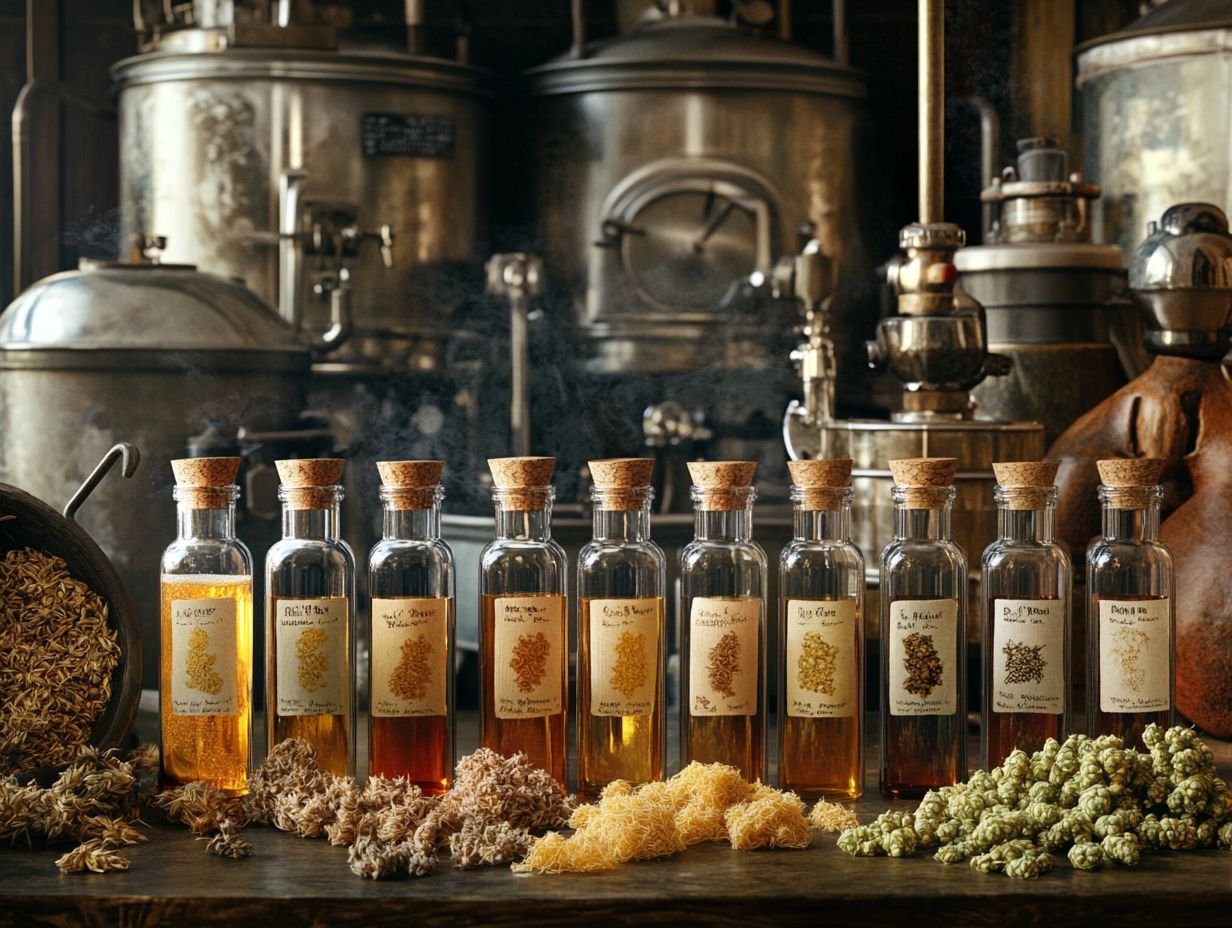
Knowing the characteristics of each yeast type can take your brewing to the next level! Factors like fermentation temperature, sugar conversion, and flocculation significantly influence the taste and texture of your final product. Yeast selection becomes a key aspect of the brewing process.
Ale yeasts are known for their high sugar conversion and fruity esters. In contrast, lager yeasts deliver a clean, crisp finish with lower sugar conversion levels. The flocculation behavior of yeast also affects clarity and mouthfeel, making your yeast choice vital.
1. Fermentation Temperature
Fermentation temperature plays a pivotal role in determining yeast activity and the overall flavor profile of your beer. Different yeast strains thrive within specific temperature ranges, so understanding these nuances is key to your brewing success.
Careful control of fermentation temperature helps prevent unwanted compounds like acetaldehyde and diacetyl, ensuring a clean and desirable yeast character in your beer.
If you re working with ale yeast, it flourishes in warmer conditions, typically between 65 F and 75 F (18 C to 24 C). This range encourages the development of fruity esters and phenolic compounds that elevate the beer’s character.
On the other hand, lager yeast prefers cooler temperatures, usually between 46 F and 55 F (8 C to 13 C), which yields a clean, crisp taste with minimal esters.
When fermentation strays from these ideal conditions, you risk compromising yeast performance, potentially leading to off-flavors or stalled fermentation. Therefore, managing fermentation temperature with precision is essential not just for the specific style you re brewing but also for achieving that perfect balance of flavors that will delight your palate.
Additionally, proper wort aeration and maintaining appropriate fermentation temperature help prevent issues such as diacetyl and acetaldehyde.
2. Flavor Profile
The flavor profile of your beer is profoundly shaped by the specific yeast strains you choose during fermentation. These strains contribute a variety of compounds, such as fruity esters and malty notes, which ultimately define the beer s unique characteristics. Understanding yeast profiles is crucial for crafting distinctive brews.
Take, for example, the ever-popular Saccharomyces cerevisiae yeast, widely used in ales. This yeast type is renowned for its ability to produce high levels of esters, yielding delightful notes of banana and clove, particularly in wheat beers and other styles like British ale. Meanwhile, distinctive Belgian strains introduce subtle spice and herbal nuances, enhancing the complexity of a saison or tripel.
When you opt for lager yeast, like Saccharomyces pastorianus, you benefit from a clean fermentation profile that allows the crisp malt flavors to truly shine. This makes it an excellent choice for styles such as pilsners, lagers, and M rzen.
Ultimately, each yeast strain acts as a unique architect of flavor, skillfully shaping the final experience of your beer and reflecting your intentions as a brewer, whether you re creating traditional beer styles or experimenting with unique strains.
3. Attenuation
Attenuation refers to the process by which yeast converts fermentable sugars into alcohol and carbon dioxide. When you work with high attenuation yeast strains, you ll produce drier beers, while low attenuation strains yield sweeter, fuller-bodied brews. For example, Kveik strains create a distinct flavor profile, while Lachancea strains offer unique characteristics.
This conversion process significantly impacts not only the alcohol content of your final product but also its mouthfeel and overall character. Different types of yeast showcase varying levels of attenuation, influenced by their genetic makeup and fermentation traits. Certain ale yeasts are celebrated for their moderate to high attenuation, resulting in balanced beers with a refreshing finish. In contrast, some lager yeasts may exhibit lower attenuation, imparting a delightful malty sweetness to the final beer.
Grasping these nuances is essential for you as a brewer, enabling you to craft the desired flavor profiles and maintain consistency in your creations, ultimately shaping the unique identity of each brew you produce.
4. Flocculation
Flocculation is the process where yeast cells gather and settle at the bottom of the fermentation vessel, playing a crucial role in the clarity and appearance of your final beer product. This mechanism also influences the visual appeal of your beer and impacts its flavor profile and mouthfeel.
Different yeast strains exhibit varying flocculation tendencies. For example, high-flocculating yeasts can produce beautifully bright and clear ales, while those that remain suspended contribute to a hazy look and a unique mouthfeel. As a brewer, you can take advantage of these properties based on the style you re crafting. Opting for flocculent yeasts can enhance clarity in lagers, while a less flocculent strain might be ideal for achieving a richer body in certain ales.
Using cleaning yeast in your brewing process can further improve the clarity and house character of your beer. Mastering flocculation is key to crafting standout beers that impress every time!
How Do Different Types of Yeast Affect the Brewing Process?
Understanding yeast types is crucial for any brewer. Let’s explore how different yeasts affect the brewing process.
The type of yeast you choose directly affects the brewing process. Each strain imparts its unique characteristics that influence fermentation time, flavor development, and even alcohol content. Different yeast types such as domestic yeasts and wild yeast strains contribute to the diversity in beer recipes.
Ale yeasts tend to ferment more rapidly, resulting in shorter brewing times and a more immediate flavor profile. In contrast, lager yeasts take their time, leading to a more refined and nuanced taste. Dive into the brewing history of ale and lager yeasts to discover their fascinating roles!
The varying behaviors of these yeasts impact the overall alcohol content of your brew. Choosing the right yeast is key to achieving your desired results.
1. Fermentation Time
Fermentation time varies significantly depending on the type of yeast you choose. Ale yeasts typically complete fermentation in just one to two weeks. Meanwhile, lager yeasts may take several weeks to reach their peak flavor and clarity.
This variation in fermentation duration can profoundly influence your overall brewing timeline. You need to thoughtfully plan and adjust your brewing schedule based on the yeast you re using.
For example, when you opt for ale yeasts that ferment quickly, you can anticipate a faster turnaround, allowing you to produce more batches in a shorter timeframe. Conversely, the slower fermentation process of lager yeasts not only extends the brewing cycle but also enhances the beer’s characteristics.
As lager yeast matures, it develops a more complex flavor profile, resulting in a smooth finish that many enthusiasts truly appreciate. Therefore, grasping the nuances of yeast behavior is essential for you to achieve the beer quality you desire.
2. Flavor Development
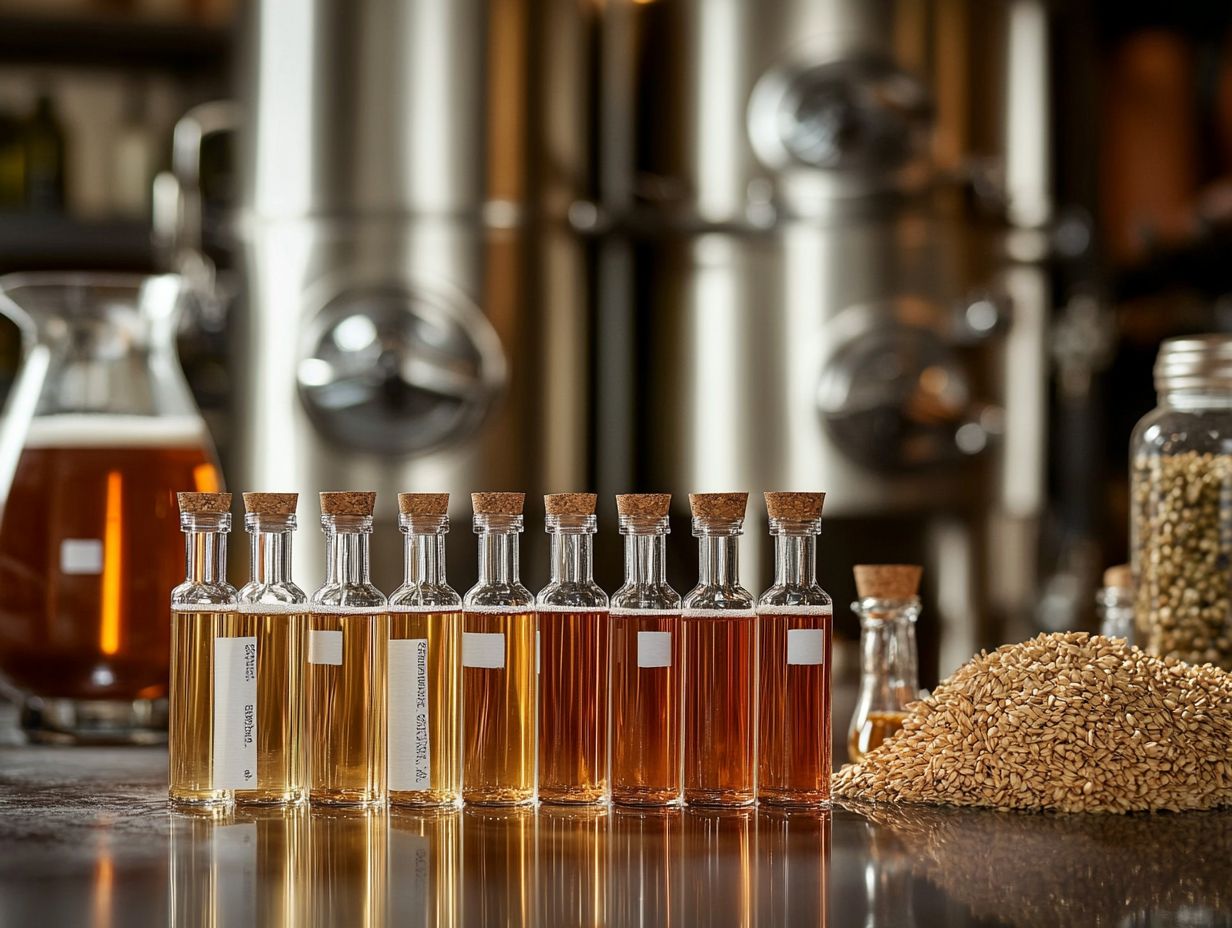
The development of flavor in beer is closely linked to the type of yeast you choose for fermentation. Each yeast strain has its own unique ability to produce distinct flavor compounds, phenolic compounds, and other elements that ultimately shape your final brew. The influence of hops combined with yeast can significantly alter the yeast character.
Take ale yeasts, for instance those delightful Saccharomyces cerevisiae strains are renowned for generating fruity flavor compounds, which impart a lovely banana-like aroma, making them perfect for styles like Hefeweizen. In contrast, lager yeasts, such as Saccharomyces pastorianus, tend to create clean and crisp profiles with fewer flavor compounds, resulting in the refreshing character of Pilsners.
Similarly, Brettanomyces can be used for sour ales to add a layer of funkiness. Let s not forget wild yeast strains like Brettanomyces, which add a touch of funkiness and earthy notes that are simply ideal for sour ales.
The interaction of these compounds doesn t just influence aroma and taste; it also plays a critical role in the overall mouthfeel and balance perception of each unique beer style you create.
Experiment with various yeast strains in your next brew to unlock exciting new flavors!
3. Alcohol Content
The alcohol content of your beer is significantly influenced by the type of yeast you choose. Different yeast strains exhibit varying levels of alcohol tolerance, which ultimately impacts the final ABV (alcohol by volume) the measure of alcohol content in beverages of your brew. Understanding yeast selection can help achieve the desired alcohol content.
When crafting high-alcohol styles like barleywine and imperial stouts, certain strains, such as Saccharomyces cerevisiae, thrive in these conditions. They convert sugars into alcohol efficiently, setting the stage for a robust final product. The use of high attenuation strains, which refers to the process by which yeast converts sugars into alcohol, is crucial in achieving desired alcohol levels.
The yeast you select affects alcohol production and plays a crucial role in shaping the complexity of the flavor profile. This is especially true for barleywines, where yeast enhances the rich, malty characteristics that define the style.
In imperial stouts, you often prefer yeast strains with a higher attenuation rate. This choice allows your bold brews to reach their maximum alcohol potential while harmonizing with the intense flavors derived from roasted malts.
Grasping these nuances enables you to make informed decisions that ultimately shape your final beer masterpiece.
What Are the Best Uses for Each Type of Yeast?
Each type of yeast presents unique advantages, making it particularly suited for specific applications within the brewing realm. This allows you, as a brewer, to craft a diverse array of beer styles that align perfectly with your desired flavor profiles and characteristics. For example, American ale and Belgian ale each offer distinct flavors and aromas.
Ale yeasts excel at producing complex and fruity beers, while lager yeasts shine in creating crisp and refreshing brews. Wild yeasts and specialty yeasts encourage exploration, paving the way for innovative beer recipes that challenge and expand upon traditional styles.
1. Ales for Complex Flavors
Ales are often brewed with ale yeast to create a remarkable range of complex flavors, from fruity to spicy notes, perfectly suited for styles like Belgian ales and IPAs. British ale yeast can develop rich, malty flavors ideal for traditional styles.
For instance, when you use Belgian yeast strains, you can enjoy distinctive flavors such as banana and clove, adding delightful depth to a Dubbel or Tripel. American ale yeast shines by highlighting citrus and floral characteristics in IPAs, offering a refreshing contrast to the bitterness of hops.
Each strain not only shapes the foundational taste but also enhances your overall drinking experience. Exploring these nuanced differences can significantly enrich your appreciation for the art of brewing!
2. Lagers for Crisp and Clean Beers
Lagers, crafted with lager yeast, are celebrated for their crisp and clean taste. They are the perfect choice for popular styles like Pilsner and M rzen, cherished for their refreshing qualities. Altbier is another lager that benefits from the clean profile provided by lager yeasts.
The brewing process begins with the fermentation of a carefully selected malt base, where Saccharomyces pastorianus (lager yeast) plays a pivotal role in transforming sugars into alcohol. This yeast thrives at cooler temperatures, enabling slow fermentation that minimizes the production of fruity esters and other undesirable flavors.
As a result, the beer develops a well-rounded profile featuring a smooth mouthfeel and a bright clarity. The addition of noble hops elevates this clean character, introducing subtle floral or earthy notes that enhance the overall experience without overwhelming it. This forms part of a diverse array of beer styles that home brewers can create.
Experiment with different yeast types to find the perfect brew for your taste!
3. Wild Yeast and Brettanomyces for Funky and Unique Beers
Wild yeast, especially Brettanomyces, plays a pivotal role in brewing, allowing you to explore funky and unique beers that cater to your adventurous palate. This yeast adds layers of complexity and character to styles like farmhouse ales and sour beers. It is a favorite among those who appreciate unique strains and the unpredictable nature of wild fermentation.
Thriving in diverse environments, this special yeast strain ferments at various temperatures, resulting in a remarkable spectrum of flavors that can range from fruity and earthy to even spicy notes. You ll find that brewers often embrace this organic fermentation process, letting the yeast interact with the ingredients and microflora in innovative ways. This interaction contributes to a distinct yeast character that is highly sought after in sour ale and other unorthodox beer recipes.
Consequently, these creations develop intriguing aromas and off-flavors, including phenolic compounds, that distinctly set them apart from more conventional beers.
By incorporating wild yeast, craft brewers like you are not just experimenting with tradition; you re also fostering a deeper appreciation for the artistry and unpredictability that come with brewing beer. This approach often results in a unique house character that defines your brand.
4. Souring Bacteria and Brettanomyces for Tart and Sour Beers
Souring bacteria, along with wild yeast like Brettanomyces, are essential for you to craft those tart and sour beers that everyone raves about, introducing a delightful acidity and complexity that give rise to beloved styles like Gose, Berliner Weisse, and sour ale.
These bacteria, including Lactobacillus and Pediococcus, play a pivotal role in the fermentation process, often transforming the flavor profiles of traditional beers into something entirely unique. By imparting a vibrant tanginess, they create a refreshing palate experience that many beer enthusiasts, including yourself, crave. This transformation is enhanced by the contributions from yeast types like Brettanomyces and Saccharomyces.
Beyond enhancing taste, these bacteria also contribute to the aroma, often lending fruity or funky notes that beautifully complement the overall brew.
With the skillful application of these souring agents, you can experiment and innovate, resulting in a diverse array of sour beers that cater to the varied preferences of your audience.
5. Specialty Yeast for Experimental Beers
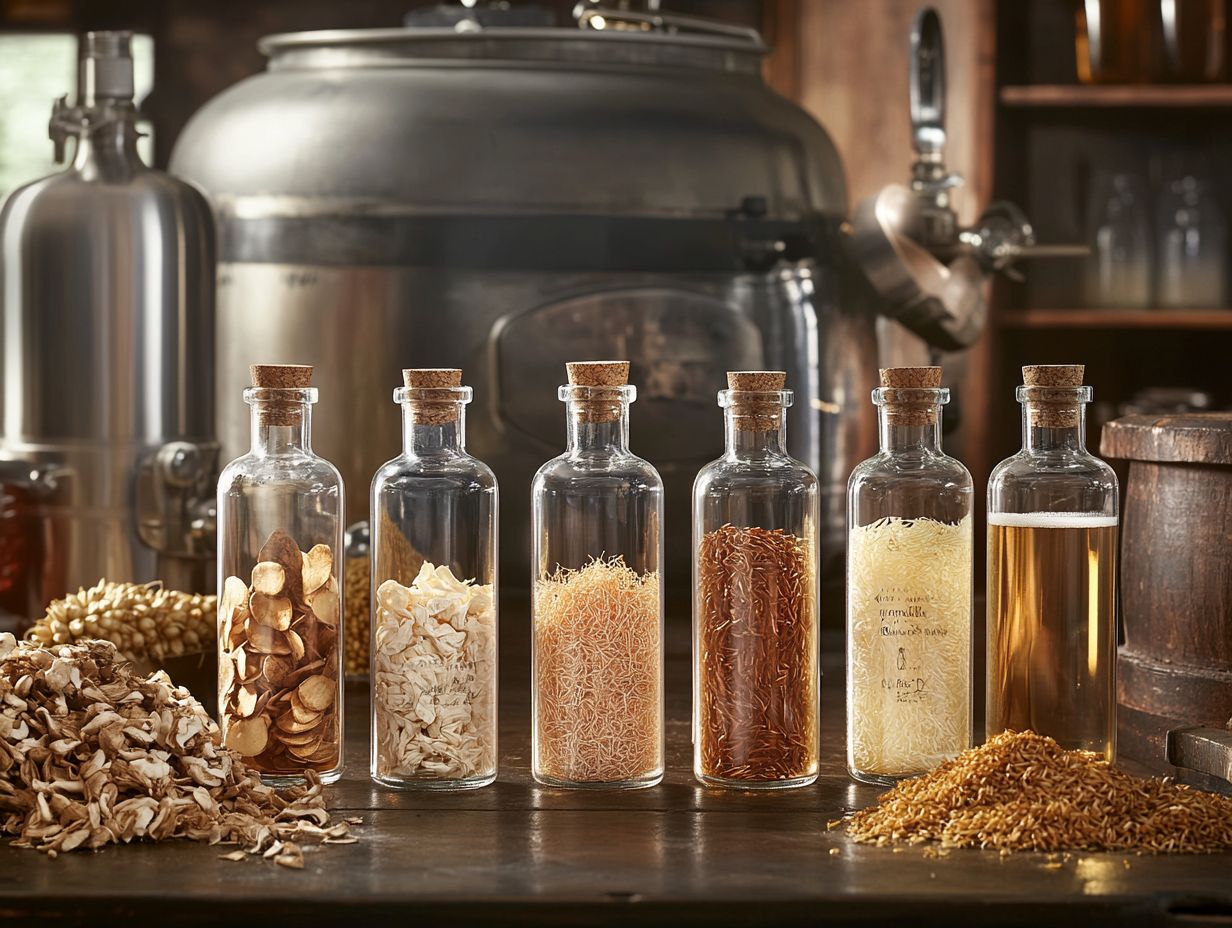
Specialty yeasts, like Kveik and Lachancea, unlock a realm of possibilities for you as a brewer, enabling you to experiment and craft innovative beers that highlight unique aromas and flavors.
These exceptional strains present diverse fermentation profiles that can yield surprising taste expressions and complexities. By incorporating such yeasts into your brewing process, you have the chance to elevate your craft, creating distinctive brews that appeal to both traditional and avant-garde palates. For example, Lachancea adds a slight acidity and fruity aroma, enriching the beer styles with its unique profile.
Take Kveik, for example; it boasts an impressive ability to ferment at higher temperatures, which means quicker brew times while imparting fruity esters and spicy phenolics that are challenging to achieve with conventional yeasts. This flexibility encourages you to embrace creative approaches, experimenting not just with base ingredients but also with various infusion methods, resulting in truly unique creations that push the boundaries of traditional brewing. This high attenuation yeast offers a remarkable tolerance to alcohol, making it ideal for strong beer styles like barleywine and Imperial Stout.
Frequently Asked Questions
What types of yeast are commonly used for brewing?
Commonly used yeast for brewing include ale yeast, lager yeast, wild yeast, and specialty yeast strains such as Belgian yeast and saison yeast. Each of these yeast types contributes differently to the brewing process, affecting the beer’s attenuation, flocculation, and overall flavor profile.
What is the difference between ale and lager yeast?
Ale yeast, including Saccharomyces cerevisiae, is top-fermenting and typically produces fruitier flavors, while lager yeast, including Saccharomyces pastorianus, is bottom-fermenting and produces cleaner, crisper flavors.
What is the role of yeast in the brewing process?
Yeast is responsible for converting sugar into alcohol and carbon dioxide. This process leads to the production of beer. The fermentation temperature and wort aeration also play crucial roles.
What are some specialty yeast strains used in brewing?
Specialty yeast strains, such as Belgian yeast and saison yeast, produce unique flavors and aromas. These strains introduce phenolic compounds and fruity esters, enhancing the beer’s profile with spicy notes and malty characteristics.
How do I choose the right yeast for my homebrew?
Consider the type of beer you want to brew and the desired flavors. Research different yeast strains and their characteristics, such as how well they convert sugar into alcohol and how they clump together after fermentation.
Are there any alternative types of yeast that can be used for brewing?
Some brewers experiment with alternative yeasts like sourdough or wine yeasts. These innovative choices can lead to exciting new flavors in your beer!

